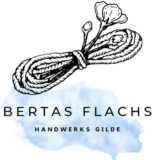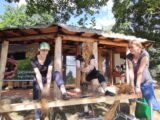No farmhouse in the upper Mühlviertel or the Bavarian Forest was complete without various statues of saints. In the corner of the room, a crucifix watched over the family, under the gable often the Virgin Mary in a small niche and above the dining table a dove usually moved with every breeze.
As a symbol of the Holy Spirit, the dove, like all other Christian symbols, was intended to bless daily activities in the home, even if its popular name doesn't sound very modest - the figure above the kitchen table was called the "Suppenbrunzer" (Soup Pince-nez)
And this name explains exactly what happened on a typical winter evening in a farmhouse parlour. After everyone at the farm had gathered around the table, the farmer's wife poured the soup into a large pot. The steam from the food and, of course, the presence of so many people in a rather small room caused the humidity to rise.
The vapour condensed on the wooden figure or the glass ball in which the dove often sat and dripped back into the soup - the bird was therefore peeing. As it was not just any feathered creature, but the holy spirit, the drops represented a blessing of the food. They also indicated to the farmer that it was now damp enough in the parlour to go straight to the loom after the meal. Flax needs high humidity in order to be spun and woven well.








